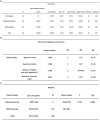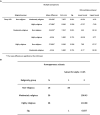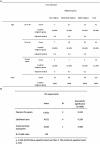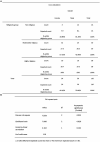Death anxiety and religiosity in a multicultural sample: a pilot study examining curvilinearity, age and gender in Singapore
- PMID: 38863661
- PMCID: PMC11165362
- DOI: 10.3389/fpsyg.2024.1398620
Death anxiety and religiosity in a multicultural sample: a pilot study examining curvilinearity, age and gender in Singapore
Abstract
This study investigated the association between multidimensional death anxiety and religiosity in multicultural Singapore by examining potential variations by age and gender. We also explored the possibility of a curvilinear effect, where highly religious or non-religious individuals report lower death anxiety than moderately religious people, forming an inverted U-curve pattern. Data were collected from 110 participants using questionnaires that assessed death anxiety and religiosity. Parametric and non-parametric tests were then conducted. The findings showed that women had significantly higher death anxiety and religiosity than men, and highly and moderately religious people had significantly higher death anxiety than non-religious people. People of all age groups had similar levels of death anxiety. These findings highlight the importance of developing targeted death anxiety interventions that integrate spiritual aspects in Singapore so that clinicians can provide culturally competent care.
Keywords: death and dying; death anxiety; existentialism; religiosity; spirituality; transdiagnostic construct.
Copyright © 2024 Belak and Goh.
Conflict of interest statement
The authors declare that the research was conducted in the absence of any commercial or financial relationships that could be construed as a potential conflict of interest.
Figures













Similar articles
-
Religiosity and Death Anxiety: A Study of Muslim Dars Attendees.J Relig Health. 2020 Feb;59(1):309-317. doi: 10.1007/s10943-019-00783-0. J Relig Health. 2020. PMID: 30810969
-
Religiosity, Religious Coping and Distress Among Outpatients with Psychosis in Singapore.J Relig Health. 2022 Oct;61(5):3677-3697. doi: 10.1007/s10943-022-01596-4. Epub 2022 Jun 25. J Relig Health. 2022. PMID: 35752728 Free PMC article.
-
Patterns of Religiosity, Death Anxiety, and Hope in a Population of Community-Dwelling Palliative Care Patients in New Zealand-What Gives Hope If Religion Can't?Am J Hosp Palliat Care. 2020 May;37(5):377-384. doi: 10.1177/1049909119891148. Epub 2019 Dec 9. Am J Hosp Palliat Care. 2020. PMID: 31818121
-
Religiosity and spirituality in the prevention and management of depression and anxiety in young people: a systematic review and meta-analysis.BMC Psychiatry. 2023 Oct 10;23(1):729. doi: 10.1186/s12888-023-05091-2. BMC Psychiatry. 2023. PMID: 37817143 Free PMC article.
-
Processes of Religious and Spiritual Influence in Adolescence: A Systematic Review of 30 Years of Research.J Res Adolesc. 2019 Jun;29(2):254-275. doi: 10.1111/jora.12486. J Res Adolesc. 2019. PMID: 31206875
Cited by
-
Cross-Cultural Differences in Fear of Death, Emotional Intelligence, Coping with Death, and Burnout Among Nursing Students: A Comparative Study Between Spain and Portugal.Behav Sci (Basel). 2025 Jul 21;15(7):993. doi: 10.3390/bs15070993. Behav Sci (Basel). 2025. PMID: 40723777 Free PMC article.
-
Sex differences in the prevalence and determinants of death anxiety among community-dwelling older adults in China: a cross-sectional study.BMC Geriatr. 2025 Aug 12;25(1):616. doi: 10.1186/s12877-025-06297-7. BMC Geriatr. 2025. PMID: 40796811 Free PMC article.
References
-
- Abdullah K., Noor N. M., Wok S. (2008). The perceptions of women’s roles and progress: a study of Malay women. Soc. Indic. Res. 89, 439–455. doi: 10.1007/s11205-008-9242-7 - DOI
-
- Ackert M., Maglakelidze E., Badurashvili I., Huber S. (2020a). Validation of the short forms of the centrality of religiosity scale in Georgia. Religions 11, 1–22. doi: 10.3390/rel11020057 - DOI
-
- Ackert M., Plopeanu A.-P. (2021). Short forms of the centrality of religiosity scale: validation and application in the context of religious individualism of orthodox and Pentecostal Christians in Romania. Religions 12, 1–29. doi: 10.3390/rel12010009 - DOI
-
- Ackert M., Prutskova E., Zabaev I. (2020b). Validation of the short forms of centrality of religiosity scale in Russia. Religions 11, 1–35. doi: 10.3390/rel11110577 - DOI
-
- Aday R. H. (1985). Belief in afterlife and death anxiety: correlates and comparisons. OMEGA J. Death Dying 15, 67–75. doi: 10.2190/GYPP-VBG3-M3AY-1ML9 - DOI
LinkOut - more resources
Full Text Sources

